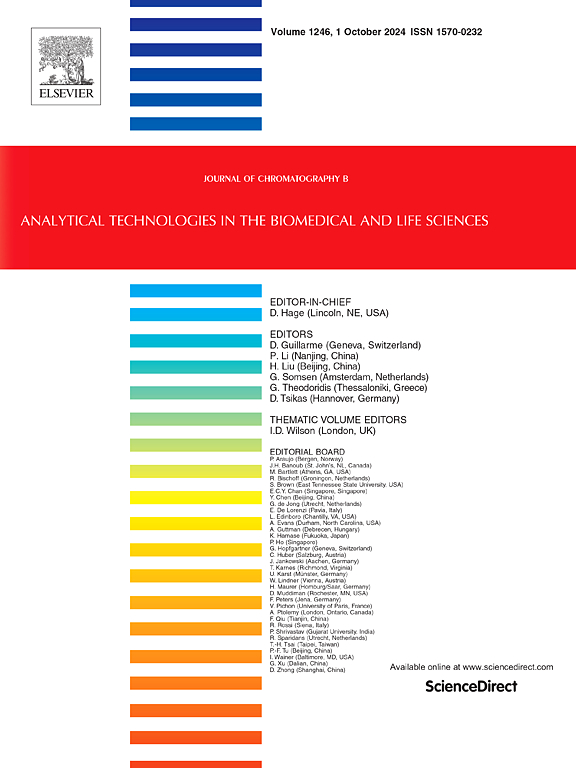Simultaneous determination of piperacillin, metronidazole, and tazobactam in plasma by UPLC–MS/MS and application to a pharmacokinetic study in pediatric liver transplant patients
IF 2.8
3区 医学
Q2 BIOCHEMICAL RESEARCH METHODS
引用次数: 0
Abstract
Piperacillin/tazobactam and metronidazole are two commonly antimicrobials used to prevent and treat infections after liver transplantation in pediatric patients. However, under the recommended dose, it may lead to insufficient antimicrobial treatment and poor efficacy. To achieve antimicrobial therapy based on pharmacokinetic strategies, a rapid and highly sensitive ultra-high performance liquid chromatography–tandem mass spectrometry (UPLC–MS/MS) method was developed to measure the plasma concentrations of piperacillin, tazobactam, and metronidazole in pediatric liver transplant recipients. Sample separation was achieved using an Acquity UPLC CSH C18 column (2.1 × 50 mm, 1.7 μm) with gradient elution. The mobile phase consisted of ammonia solution–formic acid–water (0.5:1:1000, v/v/v) and methanol–acetonitrile (1:1, v/v). The plasma concentration range was 0.20–100.00 μg/mL, with good linear range. The intra- and inter-day precisions were less than 13.4 %, and the accuracy ranged from 90.0 % to 109.0 %. The selectivity, carryover, dilution integrity, matrix effect, recovery, and stability met the requirements of the relevant guidelines. The established UPLC–MS/MS method was successfully applied to measure the concentrations of piperacillin, tazobactam, and metronidazole in the plasma of pediatric liver transplant patients. The results showed that according to the recommended dosing regimen, piperacillin/tazobactam reached the effective therapeutic target of 50 %T > MIC in only 4 h. The maximum plasma concentration (Cmax) of metronidazole ranged from 9.46 to 28 μg/mL, with an average Cmax of 16.59 μg/mL, which did not achieve the ideal Cmax/MIC ratio of 8–10.
UPLC-MS /MS同时测定小儿肝移植患者血浆中哌拉西林、甲硝唑和他唑巴坦的药代动力学研究
哌拉西林/他唑巴坦和甲硝唑是预防和治疗儿科患者肝移植后感染的两种常用抗菌药物。然而,在推荐剂量下,可能导致抗菌治疗不足,疗效差。为了实现基于药代动力学策略的抗菌治疗,建立了一种快速、高灵敏度的超高效液相色谱-串联质谱(UPLC-MS /MS)方法来测定哌拉西林、他唑巴坦和甲硝唑在儿童肝移植受体中的血浆浓度。采用Acquity UPLC CSH C18色谱柱(2.1 × 50 mm, 1.7 μm)进行梯度洗脱。流动相为氨溶液-甲酸-水(0.5:1:1000,v/v/v)和甲醇-乙腈(1:1,v/v)。血药浓度范围为0.20 ~ 100.00 μg/mL,具有良好的线性关系。日内、日间精密度均小于13.4%,准确度在90.0% ~ 109.0%之间。选择性、携带性、稀释完整性、基质效应、回收率和稳定性均符合相关指南的要求。将建立的UPLC-MS /MS方法成功应用于小儿肝移植患者血浆中哌拉西林、他唑巴坦和甲硝唑的浓度测定。结果显示:按照推荐给药方案,哌拉西林/他唑巴坦达到50% t>的有效治疗目标;甲硝唑的最大血药浓度(Cmax)为9.46 ~ 28 μg/mL,平均Cmax为16.59 μg/mL,未达到理想的Cmax/MIC比值8 ~ 10。
本文章由计算机程序翻译,如有差异,请以英文原文为准。
求助全文
约1分钟内获得全文
求助全文
来源期刊

Journal of Chromatography B
医学-分析化学
CiteScore
5.60
自引率
3.30%
发文量
306
审稿时长
44 days
期刊介绍:
The Journal of Chromatography B publishes papers on developments in separation science relevant to biology and biomedical research including both fundamental advances and applications. Analytical techniques which may be considered include the various facets of chromatography, electrophoresis and related methods, affinity and immunoaffinity-based methodologies, hyphenated and other multi-dimensional techniques, and microanalytical approaches. The journal also considers articles reporting developments in sample preparation, detection techniques including mass spectrometry, and data handling and analysis.
Developments related to preparative separations for the isolation and purification of components of biological systems may be published, including chromatographic and electrophoretic methods, affinity separations, field flow fractionation and other preparative approaches.
Applications to the analysis of biological systems and samples will be considered when the analytical science contains a significant element of novelty, e.g. a new approach to the separation of a compound, novel combination of analytical techniques, or significantly improved analytical performance.
 求助内容:
求助内容: 应助结果提醒方式:
应助结果提醒方式:


